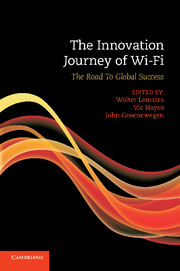Book contents
- Frontmatter
- Contents
- Figures
- Tables
- Contributors
- Preface
- Introduction
- 1 The case and the theoretical framework
- Part 1 The Wi-Fi Journey
- Part 2 The Wi-Fi Journey in Perspective
- 7 Wi-Fi in developing countries: catalyst for network extension and telecom reform
- 8 The Dutch connection to US-based NCR, AT&T, Lucent Technologies and Agere Systems
- 9 Wi-Fi as community-based innovation
- 10 The governance of radio spectrum: licence-exempt devices
- 11 Exploring the future of Wi-Fi
- 12 Reflections and implications for policy and strategy formation
- Part 3 Annexes
- Index
- References
11 - Exploring the future of Wi-Fi
Published online by Cambridge University Press: 05 June 2012
- Frontmatter
- Contents
- Figures
- Tables
- Contributors
- Preface
- Introduction
- 1 The case and the theoretical framework
- Part 1 The Wi-Fi Journey
- Part 2 The Wi-Fi Journey in Perspective
- 7 Wi-Fi in developing countries: catalyst for network extension and telecom reform
- 8 The Dutch connection to US-based NCR, AT&T, Lucent Technologies and Agere Systems
- 9 Wi-Fi as community-based innovation
- 10 The governance of radio spectrum: licence-exempt devices
- 11 Exploring the future of Wi-Fi
- 12 Reflections and implications for policy and strategy formation
- Part 3 Annexes
- Index
- References
Summary
Introduction
Wi-Fi is beyond doubt an astonishing phenomenon, primarily because it involves the almost magical capacity to carry out actions at a distance, to exert control over machines and to process data and communicate with other human beings in a cordless, immaterial and yet quite reliable manner. In addition, Wi-Fi is not only growing in terms of numbers, but is also becoming pervasive in many respects. We are not concerned so much with the remarkable features and development patterns of Wi-Fi, however, as with the open-ended questions that Wi-Fi still raises and the uncertainties and complexities it carries with it.
In this chapter, we envisage the possible futures of Wi-Fi. In the second section, we acknowledge the historical build-up and successful characteristics of Wi-Fi. In this evolution we include quantitative and qualitative evidence, as well as a few material narratives that are strongly supportive of current Wi-Fi developments. In this context, we consider what to make of the various forecasts, and how to establish the kind of knowledge perspective that users and decision makers can work with, and therefore what kind of methodological pathways may help us reach our goal. In the third section, we discuss the question of whether the future of Wi-Fi can somehow be ‘guessed’ from existing innovation models, or how to use such models in an open and helpful manner. In the fourth section, we explore the Wi-Fi journey that still lies ahead of us, in terms of options, contexts and conditions, in particular through a micro-Delphi study – i.e. a specific enquiry among experts. We present the rough output of this exploratory study in the form of potential scenarios. In the fifth and concluding section, we examine what might be some weak signals of change or, on the contrary, might be reinforcements of trends that provide early indications as to the Wi-Fi to come in the next ten years or so. We argue that one of the aspects that will be a deciding factor between the various options is the dynamic tension between innovation and regulation.
- Type
- Chapter
- Information
- The Innovation Journey of Wi-FiThe Road to Global Success, pp. 331 - 366Publisher: Cambridge University PressPrint publication year: 2010



